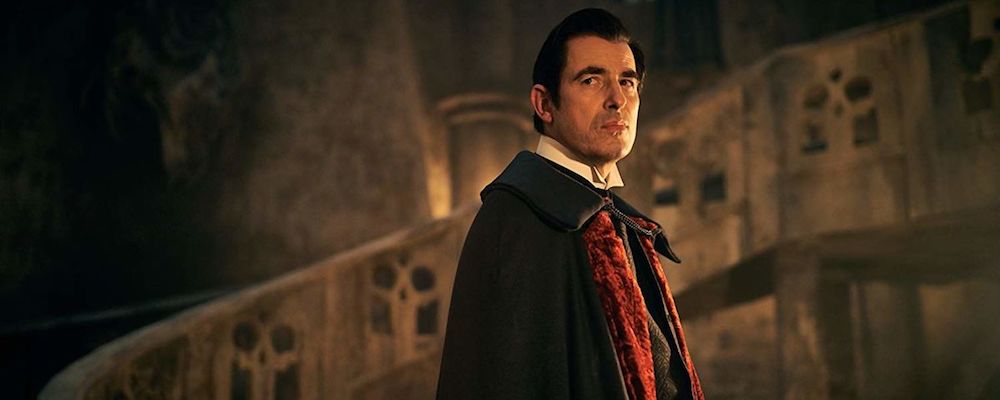‘Dracula’ Goes for the Jugular With Ghoulish Style
Alci Rengifo
“Dracula” knows that the appeal of vampires tends to be all about style mixed with twisted eroticism. This BBC One and Netflix series drips with pure atmosphere. Its look and tone are so rich that the more absurd aspects don’t matter much. They actually become absorbed into the experience. Gore and class dance together in a macabre buffet.
Divided into three episodes, each running at 90 minutes, “Dracula” begins in a secluded Hungarian nunnery, sometime in the 19th century. A deformed man named Jonathan Harker (John Heffernan) is being interviewed by some nuns. One in particular, Sister Agatha (Dolly Wells), has a keen interest in Harker’s time with Count Dracula (Claes Bang). Harker had been found washed ashore by fishermen after escaping from Dracula’s castle in, of course, Transylvania. He recounts for Sister Agatha arriving at the castle to help the Count, who greets him as a decrepit old man, with some legal papers concerning real estate. Fans of the classic Bram Stoker novel and subsequent movies can guess only some of the rest as Dracula insists Harker stay at the castle, the lawyer’s health begins to fade and he is tormented by missing his beloved Mina (Morfydd Clark). As Harker explores Dracula’s realm he is horrified to discover zombie-like figures lurking about, debauched experiments and the sudden realization that the eloquent Count is a vampire. But escaping and being taken to the nunnery is not the end of the story, for a rejuvenated Dracula, made young by sucking Harker’s life force, has also arrived in town.
“Dracula” is the creation of Mark Gatiss and Steven Moffat, who both helmed the popular BBC series “Sherlock,” which reimagined Sherlock Holmes as a glossy modern-day detective played by Benedict Cumberbatch. “Dracula” takes the Stoker classic and spins it into a feverish cocktail of subtle humor and old fashioned creepiness. It is the first half of the pilot that sticks closest to the original Bram Stoker narrative which has been refashioned so many times in other films and shows. But there are slight new angles thrown in, like Sister Agatha insisting on asking Harker if he had sex with Dracula. Pale, bald, Harker appears to have caught something from the Count? But what? It is that Dracula has taken his life force, and the direction turns the interactions between the two into a game of seduction. All the tension is between Dracula and Harker, especially after Dracula is transformed into the chiseled visage of Claes Bang. Like any good vampire, even his voice drips with malevolent charm. Classic moments from the “Dracula” story are polished into new, eerie interactions like when Dracula gazes at a picture of Harker’s fiancé, or when Harker wanders around the castle and finds Dracula asleep inside a coffin. Everything is given a baroque glow of candlelight and shadow.
Yet the show also dismisses some of the other typical Dracula decorations. Instead of finding vampire vixens like in the 1994 Francis Ford Coppola opus, when Harker snoops around he finds contorted, snarling zombies, and human experiments feasting on rats, surrounded by flies. The production values here are disturbing and fun, full of gore in the tradition of classic Hammer horror films. Dracula follows Harker to the nunnery disguised as a wolf, and when Sister Agatha walks out to confront him he doesn’t just transform, he rips out of the wolf’s body in a sack of viscera. Just wait for Dracula’s final facelift before the end credits. This “Dracula” combines the romantic aesthetic of seductive vampire yarns like “Interview with the Vampire” with the more unsettling tone of movies like Werner Herzog’s “Nosferatu” remake where Klaus Kinski’s Dracula is cursed and ugly. Claes Bang’s Dracula has slick black hair and would fit in at a James Bond convention, but he’s also capable of savage violence. When the nuns gather to pray, convinced evil has been warded off, Bang manifests himself and decapitates the sweet nun leading the prayers.
This “Dracula” also has some fun making jokes about its own premise. Dracula simply cannot go into the nunnery unless he’s invited in, and Sister Agatha essentially admits to being an atheist, she’s just obsessed with uncovering the truth about vampires and being a nun is the best gig for it. Dracula also laments that the locals near his castle “have no flavor,” which Harker mistakenly takes for a critique of their peasant state, of course the Count means it in a more literal sense.
It would have been possible to simply adapt the Stoker classic into one long miniseries, but “Dracula” turns into a broader tale of good versus evil. By the end of the pilot we realize this story isn’t about Harker escaping from the clutches of Dracula, but about a battle that will ensue between the vampire and Sister Agatha, who is soon revealed to have a very good reason in her family tree for investigating the blood-sucking creatures. Stylish, fun and darkly alluring, “Dracula” is a bloody good time.
“Dracula” season one begins streaming Jan. 4 on Netflix and BBC One.

